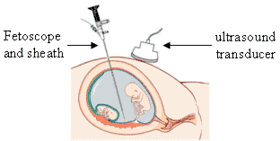Fetoscopy
| Fetoscopy | |
|---|---|
 Fetal endoscope | |
| ICD-9-CM | 75.31 |
| MeSH | D005332 |
Fetoscopy is an endoscopic procedure during pregnancy to allow access to the fetus, the amniotic cavity, the umbilical cord, and the fetal side of the placenta. A small (3–4 mm) incision is made in the abdomen, and an endoscope is inserted through the abdominal wall and uterus into the amniotic cavity. Fetoscopy allows medical interventions such as a biopsy or a laser occlusion of abnormal blood vessels or the treatment of spina bifida.[1] The field of surgical fetoscopy was developed by Dr. Ruben Quintero.[2][3]
Non-surgical fetoscopes
Fetoscopy is a surgical procedure which may involve the use of a fibreoptic device called a fetoscope. Some confusion may arise from the use of specialized forms of stethoscopes, including Pinard horns and Doppler wands, to audibly monitor fetal heart rate (FHR). These audio diagnostic tools are also called "fetoscopes" but are not related to fetoscopy.
See also
- Diaphragmatic hernia
- Fetal intervention
- Minimally invasive surgery
- Myelomeningocele
- Spina bifida
- Twin-to-twin transfusion syndrome
References
- ↑ Kohl, Thomas. Percutaneous minimally invasive fetoscopic surgery for spina bifida aperta. Part I: surgical technique and perioperative outcome.Ultrasound Obstet Gynecol 2014; 44: 515–524
- ↑ Sarah B. Pilchick (2009-01-21). "Renowned surgeon Ruben Quintero joins Miller Faculty". The Miami Hurricane. Retrieved 2012-05-03.
- ↑ Department of Obstetrics & Gynecology. "Dr. Ruben Quintero | Our Team | Fetal Therapy Center at UM/Jackson at Miller School of Medicine". Obgyn.med.miami.edu. Retrieved 2012-06-19.